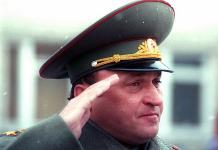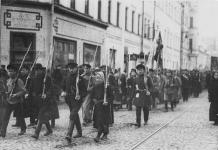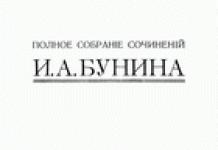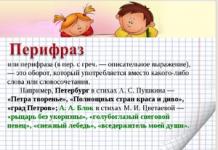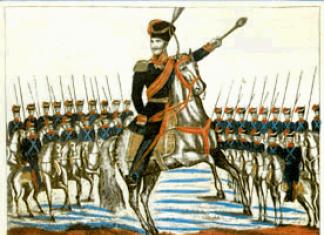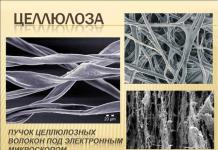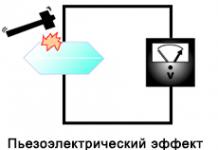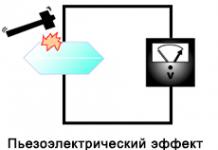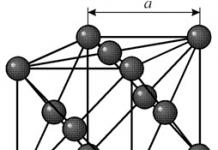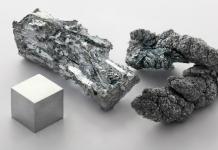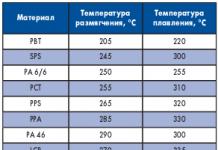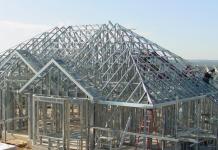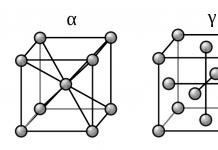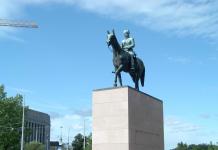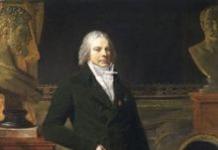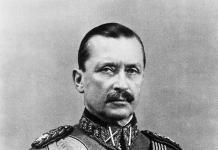Russian chemical society on the threshold of the 21st century
President of the Russian Chemical Society,
academician A.I. Rusanov
"The Russian Chemical Society is being established at St. Petersburg University with the aim of promoting the success of all parts of chemistry and disseminating chemical knowledge" - with these words begins the Charter of the Russian Chemical Society, approved by the Scientific Committee of the Ministry of Public Education on October 26, 1868. From that day, the official activity of the Society began , but work on its creation has already been carried out over a number of previous years.
In the sixties of the last century, Russian chemists acutely felt the need for an organization that would enable closer professional communication, and most importantly, would have a printed organ for the publication of scientific works of scientists in Russian. All Russian chemical scientists agreed that such a chemical society should be created in St. Petersburg, where there was the most significant community of chemists (the second largest was in Kazan, the third in Moscow). Here is what the newspaper "Russian invalid" wrote on August 17, 1861: "A chemical society, in our opinion, is quite possible in St. Petersburg. Here live our most famous chemists, Voskresensky, Zinin, Mendeleev, Sokolov, Shishkov, Khodnev and Engelhardt, - and indeed in St. Petersburg, many young people are studying chemistry." (Note that when these lines were written, Mendeleev was 27, but he is already represented among the "famous", and not "young people", among whom was, for example, 19-year-old N.A. Menshutkin). It can be noted that the Council of St. Petersburg University (its rector at that time was the "grandfather of Russian chemistry" A.A. Voskresensky) and the Faculty of Physics and Mathematics of the university (there was no chemical department yet) were very favorable to the idea of forming a chemical society at the university. With their support, it was already possible to storm the bureaucratic Everest of the Ministry. At this stage, which required a lot of energy, D.I. Mendeleev (he is actively assisted by N.A. Menshutkin) gradually becomes the main actor process and regularly informs others about step-by-step progress. It can be said that the official establishment of the Chemical Society was also his personal success.
As scientist D.I. Mendeleev was first and foremost a physical chemist, and his dream was to unite chemists and physicists. Later, in 1878, the Russian Chemical Society was transformed into the Russian Physical and Chemical Society (RFCS) with two autonomous departments - physics and chemistry - and became even more important for Russian science. An extensive scientific library was created. The RFHO journal immediately stood on a par with the largest and most authoritative scientific publications in the world. With donations from its members and other organizations, RFHO formed a bonus fund.
The first president of the Chemical Society was N.N. Zinin, second - A.M. Butlerov, third - DI. Mendeleev. In the first year of its existence, the Chemical Society grew from 35 to 60 members and continued to grow smoothly in subsequent years. It interestingly combined the features of a club (membership fees, admission only on the recommendation of three members, restrictions on visits by outsiders), a permanent chemical seminar (Mendeleev alone made a total of 90 reports in the chemical department of the Society) and a scientific publishing house. The latter was the most difficult task and required large financial assistance, which began to be provided by the universities of St. Petersburg - the University, the Technological Institute, the Mining Institute, the Artillery Academy, etc. Note that after the death of D.I. Mendeleev University buys the personal archive of the scientist from his family and creates in 1911 a memorial office (Museum-Archive) of Mendeleev (which still exists in the main building of the university), and RFHO establishes the Mendeleev Congresses on General and Applied Chemistry. The first three congresses (in 1907, 1911 and 1922) were held in St. Petersburg (Petrograd).
The revolution and post-war devastation did not change the nature of the Society's activities, although they introduced many difficulties. Lenin's government tried to rely on scientific and technical societies in the restoration of the economy. In 1918, a new statute of the Society was adopted, in which the RFHO was again established at Petrograd University and had jurisdiction over the entire territory of the RSFSR, becoming a wide open organization. In July 1918 RFHO received 70,000 rubles from the state for the resumption of activities and the publication of works. Later, however, financial difficulties increased. In 1919, the publication of the RFHO Journal had to be suspended, and it was resumed only in 1924 after the appeal of the President of the RFHO D.P. Konovalova to the Council People's Commissars. Later, in 1929 and 1930, the Supreme Economic Council and the Committee for Chemicalization of the USSR allocate significant subsidies for the publication of the RFHO Journal and the reorganization of Mendeleev's memorial office at Leningrad University.
An important act of the resumption of the Company's activities after civil war was the organization of the III Mendeleev Congress, which was held in the building of the Chemical Laboratory of Petrograd University (now the Mendeleev Center). Opening the congress on May 25, 1922, N.S. Kurnakov noted that "many persons could not arrive in Petrograd due to the difficulties of modern movement." Nevertheless, there were 406 delegates at the congress, and the reports made presented an impressive panorama of chemical science. In the future RFHO actively participates in public affairs(up to the creation of a trade union of chemists), in the creation of a Russian-speaking chemical nomenclature and the development of a plan for the chemicalization of the country.
In 1931, a wave of reorganizations swept over the scientific and technical societies and the RFHO ceased to exist. Its successor should be considered the Leningrad Scientific Research Chemical Society (actually the chemical section of the Russian Chemical Society), its presidents were N.S. Kurnakov and A.E. Favorsky. In 1937, the Leningrad Chemical Society became part of the All-Union Chemical Society. DI. Mendeleev (VHO), created in 1932 by the decision of the VI Mendeleev Congress in Kharkov (its first president was A.N. Bach). It should be noted that the creation of the WMO was carried out widely and with great support from the authorities, who apparently felt by that time the importance of influencing science.
The statute of the WHO, approved by the Presidium of the All-Russian Central Executive Committee on March 20, 1935, established the following main tasks of the society: "a) the study of the problems of chemicalization of the national economy, directly related to the key issues of socialist construction in USSR; b) promoting the development of research thought in all areas of chemical science on the basis of the Marxist-Leninist worldview; c) promoting the systematic use of all areas of chemical science to meet the needs of socialist construction and strengthen the country's defense capability. "The charter also noted that control over the activities of the WMO is carried out by the Committee for the Management of Scientists and Educational Institutions under the Central Executive Committee of the USSR, in 1938 this role passed to Academy of Sciences of the USSR.
By that time, the Academy of Sciences had moved to Moscow and was increasingly turning into the Ministry of Science, transferring many of the functions of scientific societies to itself - the publication of scientific journals (RFHO Journal was transformed into the Journal general chemistry Academy of Sciences of the USSR), organization of scientific events, preparation of recommendations to the government, etc. The Academy of Sciences more and more shielded the WMO, the role of which was objectively declining. To a lesser extent, this was felt in Leningrad, where the spirit and traditions of the Society did not actually change.
Among the new measures, the most significant was the establishment in 1941 of the annual Mendeleev readings (the first Mendeleev reader was VG Khlopin). During the years of the blockade, when books and furniture served as the main heating material, the employees of the Leningrad branch of the WMO managed to keep intact the main material value of the WMO - its library.
For the Chemical Society named after D.I. Mendeleev - an officially revered scientist in the country - sometimes played the role of a guardian angel. On the occasion of the 40th anniversary of his death in 1947, a government decree was issued that saved the memorial office of the great scientist from desolation: it was turned into a regular institution - the Museum-Archive of D.I. Mendeleev at the Leningrad University. Serious research work began to study the creative heritage of D.I. Mendeleev. In the same decree, the library of the Academy of Sciences was instructed to maintain the library of the WMO with staff and complete its funds on a gratuitous basis, so that the connection between the WMO and the Academy of Sciences was even more strengthened. True, since 1950, the WMO library had a long period of wandering around different rooms before it returned to its native land in 1987.
A.N. Bach was president of the WCO for life (from 1933 to 1946) and was the first to prove the possibility of combining the posts of Academician-Secretary of the Department of Chemical Sciences of the USSR Academy of Sciences and President of the Chemical Society (later this experience was successfully repeated A.V. Fokin). Two big anniversaries fell on his time - the 100th anniversary of the birth of D.I. Mendeleev in 1934 and the 75th anniversary of the WMO and the Periodic Law in 1944 (celebrated jointly), which could not but attract the attention of the government of the country. In 1936 A.N. Bach spoke at the Presidium of the Central Executive Committee of the USSR with a report on the work of the WHO, after the approval of which the WHO and its Moscow branch were allocated premises in Moscow. The next event was the entry into the All-Union Scientific Engineering and Technical Society of Chemists, as a result of which the society not only increased noticeably, but also began to include not only scientists.
A.N. Bach as president of the WHO became MM. Dubinin(from 1946 to 1950, when he was elected academic secretary, he was replaced by V.M. Rodionov). We obtain information about the number of WMOs of that time from "Communications on the scientific work of members of the WMO named after D.I. Mendeleev", vol. 1 for 1948, where an appeal to I.V. Stalin on the occasion of the 30th anniversary of October: "The remarkable successes of socialist construction, the daily assistance of the party and government, and yours personally, dear Joseph Vissarionovich, ensured an unprecedented flourishing of science and a powerful development of industry in our country. These exceptionally favorable conditions allowed the WMO to significantly develop its activities and bring the number of members to 6,000 by uniting them in 36 local branches organized in various regions of the Union."
So, in 1948, the Chemical Society had 6,000 members, and this was perceived as a significant achievement. Indeed, if compared with 60 members in 1869, then over the 82 years of its existence, the Society has grown 100 times, despite significant human losses during the wars. On the other hand, the size of the Society was obviously much less than the total number of people who were related to chemistry in the USSR. This testified to the predominantly scientific character of the Chemical Society at that time: the spirit and principles laid down by the founders of the Society still continued to exist.
This was put to an end on December 24, 1954 by a resolution of the Central Committee of the CPSU "On Scientific Engineering and Technical Societies". It, among many other remarks, in particular, about the weakening of ideological work, noted that scientific and technical societies (STOs) did not become "genuinely mass" organizations of scientific and technical workers and innovators in production. A coherent management scheme for the NTO was developed: the party - the trade unions - the NTO, and the NTO were directly subordinate to the All-Union Central Council of Trade Unions. The sectoral trade unions were glad and proud that they were leading science to some extent. For party functionaries, work in the NTO has become completely unprestigious. We remembered the functionaries not in vain: a gigantic increase in the number of members of the NTO was coming (by the end of the 70s, it reached 550 thousand people in the WHO) and a corresponding increase in the administrative apparatus. The NTO had its own bureaucracy.
These changes and the beginning of the restructuring of the work of the Society fell on the fleeting presidency of I.L. Knunyants ( 1954-1956) after the death of V.M. Rodionov. A new statute of the WMO was developed with a detailed study of various areas of activity, and after the rubber and rubber industry joined the WMO VNITO, the technical bias in the Society increased noticeably. In the new charter, the word "board" was first mentioned (in the former Soviet era, the Society was led by an "organizing committee" or "council"), and the first chairman of the board of the WHO was I.P. Losev- a scientist of a more applied direction than the academic I.L. Knunyants, who focused on the work of the scientific journal of the Society.
As a result of this reform, the WMO turned from a scientific into a scientific and technical society and approached the sectoral NTOs, while still being very different in spirit from them. This also had its positive sides. First, the WMO expanded its scope and went beyond pure science, where it was largely shielded by the Academy of Sciences. Secondly, the ministries of the chemical profile began to transfer (by order from above) significant funds for the maintenance of the WMO, which made it possible to create permanent staff, send members of the WMO on business trips, and establish awards and competitions. The state took the NTO on its own, but also transformed them in the image and likeness of a socialist public organization: with primary organizations (subordinate to trade union committees) and democratic centralism with an annual planned target for the growth of its ranks.
I.P. Losev and who replaced him in 1963. S.I. Volfkovich turned out to be presidents of the WMO for life. Worked quietly under the auspices of the trade unions and with budget support, until some major event brought the WMO to the surface of public life. Usually these were the Mendeleev congresses, held on a large scale every 4-5 years as a review of the achievements of domestic chemistry. It should be noted, however, that after a huge break of 25 years (from 1934 to 1959) in holding congresses, the leading role in new series At the congresses, the Academy of Sciences began to play as a state structure of the highest scientific qualification (a number of interested ministries were also involved), and this position was brought during the years of stagnation to almost complete unity of command. By this time, the role of the party had been absolutized to the limit, and therefore a separate resolution of the Central Committee of the CPSU for each congress was a guarantee of success, ensuring, on the one hand, the congresses were crowded and a high circle of keynote speakers, and, on the other hand, the diligence of the local party leader during the congress in the regions. All this brought undoubted benefits to the Chemical Society, although relegated to the shadows.
Anniversary congresses were organized especially solemnly and with the invitation of honorary foreign guests, one of which was dedicated to the 100th anniversary of the birth of A.M. Butlerov, was held in Kazan in 1928 (later the Butlerov Readings were established in Kazan by the Tatar branch of the WHO), and three others were held in Leningrad: the VII Anniversary Mendeleev Congress, dedicated to the 100th anniversary of the birth of D.I. Mendeleev, in 1934; The X Anniversary Mendeleev Congress, dedicated to the 100th anniversary of the Periodic Law, in 1969 and the XIII Anniversary Mendeleev Congress, dedicated to the 150th anniversary of the birth of D.I. Mendeleev, in 1984. The latter was already held with the new president of the WMO A.V. Fokin, who came to this post immediately after the death of S.I. Volfkovich in 1981 and remained devoted to the Chemical Society until the very last days WMO after the collapse of the USSR.
150th anniversary of D.I. Mendeleev was marked by a joyful event for the WMO - the creation of the Mendeleev Center at Leningrad University. The Chemical Society and Leningrad University jointly prepared a draft decision of the USSR government on this issue, and it was adopted in 1982. By that time, it became possible to return the Chemical Society to the building of the Research Institute of Chemistry (the building of the Chemical Laboratory of St. Petersburg University), which after that became known as the Mendeleev Center. In May 1984, by the beginning of the congress, the renovated Museum-Archive of D.I. Mendeleev and the first stage (right wing) of the Mendeleev Center, where the board of the Leningrad branch of the Chemical Society entered. The second stage (left wing) of the Mendeleev Center - a room for the library of the All-Union Chemical Society - required extensive restoration work and was put into operation only in 1987, and all the work was carried out at the expense of the All-Union Chemical Society.
At the same time, the office of the chemical society in the Mendeleev Center was being equipped: a large bronze bust of Mendeleev by the sculptor L.K. Lazarev, and the artist Yu.N. Sukhorukov in two years created a monumental mosaic panel in the meeting room of the board, immortalizing in stone the greatest chemists of the St. Petersburg school since the founding of the Society. Many things from the apartment of V.E. were transferred there by the university. Tishchenko (who lived in the same building as the closest and, perhaps, the most selfless associate of D.I. Mendeleev in the chemical society). All of them have been carefully restored by the Chemical Society.
The creation of the Mendeleev Center is difficult to overestimate. It really is the center of chemical life in St. Petersburg, and not only in this city. For example, Novosibirsk chemists usually hold conferences on catalysis at the Mendeleev Center. The center also has important representative functions for the university: the British ambassador to the USSR (who, by the way, offered chemists to invent unbreakable porcelain), the consul of India in St. Petersburg, a delegation from Stockholm University, the president of the American Chemical Society and many other officials have been here.
The Mendeleev Center is working at full capacity even in our difficult days. If we draw an analogy between the incomparably more difficult crisis period after the civil war and the current state of the economy, then the advantage of the former is revealed: then the NTOs were very necessary for the state, and now the state does not need them in the least. Deprived of state subsidies, many NTOs have lost the ground under their feet and the meaning of their existence. This is especially true of those NTOs that were created artificially only to match the existing branches of the national economy of the USSR. It must be said that the WMO showed its relatively high survival rate and even set a longevity record after the collapse of the USSR, formally existing until 1993, when it announced its dissolution during the XV Mendeleev Congress in Minsk.
Even earlier, in 1992, in Rostov-on-Don, the WCO organized the founding conference of the Russian Chemical Society. DI. Mendeleev (RHO) as the successor of the WMO in Russia. President-organizer, and then the first president of the RCS for the period 1992-1995. became Yu.A. Zolotov, second president (since 1995) - the author of these lines. At the congress in 1993 in Minsk, the Federation of Chemical Societies named after V.I. DI. Mendeleev, designed to replace WMO in the new conditions. The Federation does not receive contributions from its members, and the headquarters of this organization in Minsk exists at the Academy of Sciences of Belarus thanks to the selfless care of its first (from 1993 to 1995) president I.I. Lishtvan. In fact, some activity is shown in the federation by the countries participating in the Bialowieza agreements, Kazakhstan and Uzbekistan are symbolically designated. And yet the existence of the federation is fundamentally important: let it help us not to forget each other and orient us towards better times.
How and on what to live the Society further? Let us recall that the Chemical Society already existed under capitalism. From its first charter we learn that, firstly, the members of the Society paid considerable membership dues (10 rubles per year), and, secondly, "for the development of the society's funds, donations are accepted from members, outsiders and institutions, which are published in protocols." Now we know that the first sponsors of any organization are its founders. The founders of the Russian Chemical Society in 1868 were private individuals with a fairly high income, for they were scientists and professors. Even according to the data of 1913, a university professor received 4,500 rubles a year, one of the most stable currencies in the world: - 300 rubles more than a deputy of the State Duma, and 5 times more than the most skilled worker (what train drivers were then). Under those conditions, when the number of the first composition of the RCS was insignificant, and the level of all kinds of donations from its members (up to the formation of bonus funds) was high, and the Society did not have full-time employees, the funds contributed were quite enough for its functioning at first.
The founders of the new RChO in Rostov differ significantly in their financial capabilities from the founders-forefathers, although, I recall, they demonstrated, presumably, no less enthusiasm. But, most importantly, we have not yet felt ourselves in a new world, where it is customary to start any new business with an estimate. A reasonable proposal to introduce into the charter a valid (with a high fee) and associated membership in the RCS did not pass then, and now we have to return to it again.
Nevertheless, the charter of the modern RMO reflects the principles laid down in the first charter. The bottom line is that the Chemical Society now lives on voluntary contributions, both membership and sponsorship. However, in order to receive them regularly, the Society must convincingly demonstrate its usefulness.
The main "commodity" of any scientific society is information, and in the example of the American Chemical Society, with its annual budgets of several billion dollars, we see how much can be achieved along this path. The American Chemical Society publishes a lot of scientific journals (in our case, this function is carried out by the Russian Academy of Sciences), but the main information publication is Chemical & Engineering News.
Now the Russian Chemical Society has its own, albeit modest, analogue - the bulletin "Chemistry in Russia", published since last year (editor V.N. Parmon) and becoming more and more popular. The members of the Society who receive it are keenly interested in the subsequent numbers, and this indicates that we are on the right track. Of course, this publication is not profitable, but costly, but it's nice to think that sponsors' expenses are beneficial here.
As for the "Journal of the All-Union Chemical Society named after D.I. Mendeleev" (the origins of this journal come from the first printed organ of the Russian Chemical Society, founded in 1869 by D.I. Mendeleev), then in 1993 its successor was the "Russian chemical journal. At present, despite the great difficulties with funding, this magazine is published regularly, preserving the main traditions of its predecessor.
It is especially difficult for regional RMO organizations to prove their usefulness. The greatest (even unique) opportunities have the St. Petersburg branch, which free of charge provides its members with the use of an excellent library and the premises of the Mendeleev Center. But in a number of other regions (for example, in Tatarstan), where they begin to work correctly with their members and sponsors, things are moving towards improvement, although we still need to learn a lot about this (first of all, work with sponsors).
There are also great difficulties in the work of the board of the RCS in Moscow. The once numerous apparatus of the central government was reduced to three people, and the premises on Krivokolenny, 12 (formerly - whole floor) - up to two rooms (with a high rent for one of them). Within the limits of its strength, a small team works selflessly for the whole of Russia and has gone through trials recent years thanks to the energy and authority of the executive director and vice-president of the Russian Chemical Society V.F. Rostunov.
It should be noted that in Moscow there is also the board of the Moscow Chemical Society as part of the Russian Chemical Society. Although Moscow provides, in all likelihood, half of the potential members of the Chemical Society in Russia, the existence of the apparatus of the two boards in Moscow, in the current financial situation, is an unaffordable luxury, and it would be rational for them to voluntarily merge into a common apparatus of the two boards.
Huge work on the line of the board of the RCS is carried out by the first vice-president P.D. Sarkisov. Thanks to his efforts, it seems that the issue of a new office for the board of the RCS and the creation of a professional chemical library for members of the RCS in Moscow is being resolved. Taking this opportunity, I want to thank other vice-presidents, members of the presidium and the board of the RCS for their selfless work for the benefit of domestic chemistry.
According to the latest registration, the number of members of the RCS is approaching two thousand. In practice, we have already reached the size of the WCO in 1935, or, for example, the size of the modern Swiss Chemical Society, and this is already not bad. The potential opportunities of the RCS, as well as of Russia itself, remain among the highest in the world, which allows us to look to the future with optimism.
named after D. I. Mendeleev All-Union, scientific society. It is administered by the All-Union Council of Scientific and Technical Societies (VSNTO) under the All-Union Central Council of Trade Unions (AUCCTU). Organized in 1932 by decree of the VI Mendeleev Congress on General and Applied Chemistry as a voluntary association of chemists - scientists, engineers, technicians, teachers, workers - innovators of production, regardless of their departmental affiliation. H. o. - the successor of the Russian Chemical Society (R. Kh. O.), founded at St. Petersburg University in 1868 by decision of the meeting of the chemical department of the 1st Congress of Russian Naturalists and Doctors and transformed in 1878 into the Russian Physical and Chemical Society (R. F.-kh . about.). Charter R. x. about. was compiled with the active participation of D. I. Mendeleev and N. A. Menshutkin. The first president R. x. about. N. N. Zinin was elected; N. A. Menshutkin was the editor of the Journal of the Russian Chemical Society (renamed in 1879 the Journal of the Russian Physical and Chemical Society) from 1869 to 1900. In the period 1868-1917, the society consisted mainly of professors and teachers of higher educational institutions and very few industrial workers (10-12%). The number of members of the society in 1869 was 60 people. (129 in 1879, 237 in 1889, 293 in 1899, 364 in 1909, 565 in 1917). The presidents of the society were A. M. Butlerov (1878-82), D. I. Mendeleev (1883-84, 1891-92, 1894), and other prominent chemists. D. I. Mendeleev, N. A. Menshutkin, D. P. Konovalov, M. G. Kucherov and others made scientific reports in the society.
After the Great October Socialist Revolution, the number of members of the society increased sharply, the content, form and volume of its work changed. The main thing in his activity was: attracting chemists and other specialists, young students and advanced workers to scientific and technical creativity, improving socialist production; all-round advanced training of workers in science and industry: propaganda of the successes of chemistry among the broad masses of working people. Scientific, technical and specialized sections, committees, commissions, and brigades. The public universities of technical progress, of raising the scientific and technical knowledge of the members of the Kh. o., have gained great popularity. Together with the Academy of Sciences of the USSR and other organizations, the society holds Mendeleev congresses on general and applied chemistry. There were II such congresses from 1907 (in St. Petersburg) to 1975 (in Alma-Ata). Reports at the congresses were made by: A. E. Arbuzov, A. N. Bakh. N. D. Zelinsky, N. S. Kurnakov, L. D. Landau, N. N. Semenov, A. E. Fersman, V. G. Khlopin, and others. scientists, as well as foreign scientists F. Joliot-Curie, G. Seaborg, R. Robinson, S. Hinshelwood, A. Todd, and others. Proceedings of the Mendeleev Congresses are published in the form of collections. H. o. also convenes thematic conferences, symposiums, meetings, organizes discussions, many of which are organized with the participation of other interested scientific and economic institutions.
H. o. organizes competitions of scientific and production-technical works of its members. Since 1965, the Presidium of Kh. together with the Presidium of the Academy of Sciences of the USSR, they award a gold medal to them in competitions. D. I. Mendeleev for works in the field of chemical sciences and technology that have an important theoretical or practical value. Presidium H. o. together with sectoral ministries and trade unions, annually reviews the implementation of plans for the introduction of scientific and technological achievements in national economy and measures to improve the technical level, quality and reliability of chemical products.
In 1976, the H. o. included 86 local branches (boards) in the republics and major cities THE USSR. H. o. has (1976) about 320,000 members and over 140,000 young chemists - secondary school students.
H. o. has its own publications: “Journal of the All-Union Chemical Society named after V.I. D. I. Mendeleev” (6 issues per year) and the journal “Rubber and Rezina” (published jointly with the Ministry of Petrochemical and Oil Refining Industry of the USSR).
Lit.: Kozlov V. V., Essays on the history of chemical societies of the USSR, M., 1958; his own, the All-Union Chemical Society. D. I. Mendeleev. 1868-1968, M., 1971; All-Union Chemical Society. D. I. Mendeleev. Information and exchange of experience, M., 1972.
V. V. Kozlov.
- - them. D. I. Mendeleev, as part of the Union of Scientific. and eng. about-in Russia. Assignee Vses. chem. about-va, created in 1932 and leading the history from Rus. chem. about-va, osn. in 1868...
- - see Chemical contamination ...
Civil protection. Conceptual and terminological dictionary
- - an increase in the number of chemical components of a certain environment, leading to a change in its natural chemical properties ...
- - introduction of pollutants into the environment chemical substances, alien to it or in concentrations exceeding the background, posing a threat to people, farm animals and plants during ...
- - dissemination of hazardous chemicals in the environment in concentrations or quantities that pose a threat to people, farm animals and plants for a certain time ...
Emergency Glossary
- - type of weapon mass destruction, the action of which is based on the use of combat agents, toxins and phytotoxicants. Includes single-use and reusable chemical munitions...
Emergency Glossary
- - created. in 1878 by the association of Rus. physical and Rus. chem. societies. Congresses and publications about-va were the important form of the organization nauch. activities in Russia until 1917...
Natural science. encyclopedic Dictionary
- - see weathering...
Geological Encyclopedia
- - one of the main oppositions of history and philosophy of history ...
Philosophical Encyclopedia
- - "...6.15...
Official terminology
- - Pai - a word introduced into Russian chemical literature by Academician Hess; it was supposed to replace "equivalent", as can be seen from the following extract from his Foundations of Pure Chemistry: ".....
Encyclopedic Dictionary of Brockhaus and Euphron
- - The essential oil of P. is obtained by distilling the leaves and branches of the Pogostemon Patchouli plant with water. From 100 kg they are expelled on average about 1750 gr. oils...
Encyclopedic Dictionary of Brockhaus and Euphron
- - the Russian Physical Chemical Society at the Imperial St. Petersburg University was formed on the initiative of D. I. Mendeleev in 1878 from the merger of two separate societies, physical and chemical ...
Encyclopedic Dictionary of Brockhaus and Euphron
- - them. D. I. Mendeleev - as part of the Union of Scientific and Engineering Societies of Russia. The assignee of the All-Union Chemical Society, established in 1932 and leading the history from the Russian Chemical Society, founded in 1868 ...
- - RUSSIAN PHYSICAL AND CHEMICAL Society - created in 1878 by the union of the Russian Physical and Russian Chemical Societies. The congresses and publications of the society were an important form of organization scientific activity in Russia until 1917...
Big encyclopedic dictionary
"Chemical Society" in books
Chemical weapon
authorChemical weapon
From the book Secrets of the Insect World author Grebennikov Viktor StepanovichChemical weapons Among the dazzling white salt marshes along the lake sloping shore - an unexpected island of bright green grass. And large black and purple insects crawl on the grass. From under the small, covering nothing elytra looms a huge,
Chemical weapon
From the book Drugs and Poisons [Psychedelics and Toxic Substances, Poisonous Animals and Plants] author Petrov Vasily IvanovichChemical weapon
CHEMICAL ACTION
From the book Teachings of the Temple. Volume I author author unknownCHEMICAL ACTION The states of matter commonly referred to by students of occult science as akashic, ethereal, watery, and fiery, contain the base gases known to exoteric science as steam-hydrogen, steam-oxygen, oxygen-hydrogen, and nitrogen.
1.2.7. The fifth meaning of the word "society" is a society of a certain type in general (a type of society, or a particular society)
From the book Philosophy of History author Semenov Yuri Ivanovich1.2.7. The fifth meaning of the word “society” is a society of a certain type in general (a type of society, or a special society). Socio-historical organisms have existed and still exist in a huge number. It is impossible to understand this multitude without classifying sociohistorical
6. The fifth meaning of the word "society" is a society of a certain type in general (a type of society, or a particular society)
From the book Course of Lectures on Social Philosophy author Semenov Yuri Ivanovich6. The fifth meaning of the word "society" is a society of a certain type in general (a type of society, or a special society). Socio-historical organisms have existed and still exist in great numbers. It is impossible to understand this multitude without classifying sociohistorical
Chemical weapon
From book Big Encyclopedia technology author Team of authorsChemical weapons Chemical weapons - toxic substances and various means of their combat use (artillery chemical shells, aerial bombs, mines, chemical land mines, hand chemical grenades, poisonous smoke bombs, rockets).
TSBchemical affinity
From the book Big Soviet Encyclopedia(HI) author TSB11.2.2. Chemical damage
From the book Therapeutic Dentistry. Textbook author Borovsky Evgeny Vlasovich11.2.2. Chemical damage Chemical damage (trauma chymicum) can be either acute or chronic. Acute damage occurs as a result of exposure to the mucous membrane of chemicals in a highly damaging concentration. Most often this happens when
Markovnikov's rule, Menshutkin's reaction, Borodin's reaction, Mendeleev's table... The authors of these and many other discoveries belong to the brilliant constellation of chemists who created the Russian Chemical Society.
At the end of December 1867 - at the beginning of January 1868, the first congress of Russian naturalists and doctors took place in St. Petersburg. At the congress, it was announced: "The Chemical Section declared its unanimous desire to unite in the Chemical Society for the communication of the already established forces of Russian chemists." Congress participant Vladimir Vasilievich Markovnikov (1837-1904) recalled: “The section was not distinguished by its large number of representatives ... but they were full of faith ...; they were firmly convinced of the success of the work they were undertaking and boldly looked forward, ... everyone believed that the forces would grow rapidly. The founders of the Russian Chemical Society were considered to be all members of the chemical section of the congress who prepared the resolution of the organization. In the same year, a photograph was taken of 19 founders of the Russian Chemical Society.
Founders of the Russian Chemical Society. 1868.
Zinin N.N.
Chemists in Heidelberg. 1859-1860. From left to right: N. Zhitinsky, A. Borodin, D. Mendeleev, V. Olevinsky.
The photograph shows the faces of those who have already established themselves as talented scientists, and those who are yet to become among the world's leading scientists, there are also those who have made their own contribution to the development of chemistry in Russia. First row (from left to right): Richter Viktor Yulievich (1841-1891), Kovalevsky Stepan Ivanovich (? - 1907), Nechaev Nikolai Pavlovich (1841-1917), Markovnikov Vladimir Vasilyevich (1837-1904), Voskresensky Alexander Abramovich (1809-1880 ), Ilyenkov Pavel Antonovich (1821-1877), Alekseev Petr Petrovich (1840-1891), Engelhardt Alexander Nikolaevich (1832-1893), second row (from left to right): Vreden Felix Romanovich (1841-1878), Lachinov Pavel Alexandrovich (1837 -1892), Schmidt Gustav Avgustovich (1839-?), Shulyachenko Alexei Romanovich (1841-1903), Borodin Alexander Porfirievich (1833 - 1887), Menshutkin Nikolai Alexandrovich (1842-1907), Sokovnin Nikolai Alexandrovich (1835 -?), Beilstein Fedor Fedorovich (1838-1906), Lisenko Konon Ivanovich (1836-1903), Mendeleev Dmitry Ivanovich (1834-1907), Savchenkov Fedor Nikolaevich (1831-1900).
The date of the photograph is January 5, 1868, this date is indicated in chalk on the column shown in the photograph. Unfortunately, we do not know who photographed the group, but the names of 17 scientists in the picture were personally signed by D. I. Mendeleev, apparently, he did not know two of them, and, perhaps, did not remember at that time, the names N .BUT. Sokovnina and N.P. Nechaev is not indicated by him in the photograph. It is possible that the idea of photographing could belong to him. It is well known that Mendeleev was seriously engaged in photography, paid great attention to its development in Russia, and called photography the second sight of man. In addition, Mendeleev was one of the founders of the V photographic department of the Russian Technical Society. Unfortunately, not all the founders of the RCS were photographed, for example, Nikolai Nikolaevich Sokolov (1826-1877), Leon Nikolaevich Shishkov (1830-1908) and some others are not on it.
The official activity of the Russian Chemical Society began on October 26, 1868, on this day its charter was approved, it began with the words: “The Russian Chemical Society is being established at St. Petersburg University in order to promote the success of all parts of chemistry and disseminate chemical knowledge.”
On December 5, 1868, the patriarch of Russian chemists Nikolai Nikolaevich Zinin (1812 - 1880) was unanimously elected chairman of the society, N.A. Menshutkin and treasurer - G.A. Schmidt. Members of the society expressed their gratitude to D.I. Mendeleev and N.A. Menshutkin for their work on the organization of the Russian Chemical Society. On March 6, 1869, chemists who gathered for a regular meeting of the RCS learned about the discovery periodic law chemical elements, report at the request of D.I. Mendeleev was read by N.A. Menshutkin. In the first year of its existence, the RCS included 48 people, and by the 25th anniversary of the society, the number of members increased to 245.
Let's try to answer two questions: why did the chemical society appear in Russia in the 60s of the 19th century, and why did St. Petersburg become its birthplace? It was a time of great shifts and the awakening of self-awareness in the life of Russian society, feature his desire for natural sciences especially in chemistry. Not only young people aspired to study the natural sciences, but often people who had already managed to acquire a certain position in society, they left their studies in order to sit down again on the university training bench. For some, a hobby for chemistry was a fashionable trend, while someone preferred to do not an abstract, but a real thing. At the same time, they were guided not by material calculations, but by the consciousness of the need to receive an education. In the field of chemistry at that time, differentiation into three main branches was clearly outlined - inorganic, physical and organic, the latter took first place in terms of the volume of material studied.
By the middle of the 19th century, several chemical centers had formed in Russia, the largest was the center in St. Petersburg, in second place was the center in Kazan, in third place was in Moscow. The school of chemists that took shape at the Academy of Sciences, at St. Petersburg University, at the Mining Institute, at the Medical and Surgical Academy, at the Mikhailovskaya Artillery Academy, at the Technological Institute, at the Agricultural (Forestry) Institute, had a huge impact on the development of chemistry not only in Russia, but also in the world. On August 17, 1861, the Russian Disabled newspaper wrote: “A chemical society, in our opinion, is quite possible in St. Petersburg. Our most famous chemists live here. Voskresensky, Zinin, Mendeleev, Sokolov, Shishkov, Khodnev and Engelhardt - and indeed in St. Petersburg many people study chemistry. Why don't our scientists group a whole society around themselves? It is noteworthy that the newspaper noted three chemists who, seven years later, were photographed by the founders of the RCS. It should be noted that by 1868 the London Chemical Society, the French Chemical Society, and the German Chemical Society had already been established. In September 1860, the first International Congress of Chemists took place in Karlsruhe, and Russian chemists took part in it, including D.I. Mendeleev, A.P. Borodin and others.
The Russian Chemical Society in St. Petersburg was not created from scratch; scientific chemical circles had already worked in this city before. In 1857, on the initiative of N.N. Sokolov and A.N. Engelhardt, he is in the photograph, such a circle was organized and at their expense a private ("public") chemical laboratory in their apartment on Galernaya Street. The success of the laboratory, which was open to everyone for a small fee, exceeded all expectations, but it was clear that such a private institution as a chemical laboratory, if only for material reasons, could not exist for a long time. In 1860, three years after its foundation, the activity of the laboratory was terminated, and all the equipment was donated to St. Petersburg University. Sokolov and Engelhardt founded the first Russian journal on chemistry "Chemical Journal", published in 1859-1860. The main goal of the journal is “to make it convenient for those involved in chemistry in Russia to follow modern development science and understand it quite clearly. Another chemical circle in 1854 was organized by P.A. Ilyenkov, we also see him in the photo. In the mid-sixties in St. Petersburg, chemists regularly gathered at the apartments of D.I. Mendeleev, A.A. Voskresensky and A.P. Borodin, future participants in photography. Here scientific works were discussed and debates were held on issues theoretical chemistry. Similar useful social initiatives in St. Petersburg in the 1850s and 1960s led to the unification of Russian scientists working in the field of chemistry and the organization of the Russian Chemical Society.
What, besides passion for chemistry and the Russian Chemical Society, united the founding members shown in the photograph? First of all, the overwhelming majority of them were young scientists aged 27-35. Many of them are students of A.A. Voskresensky - "the grandfather of Russian chemistry" (as he was often called). This is D.I. Mendeleev, N.A. Menshutkin, P.A. Ilyenkov, A.R. Shulyachenko, P.A. Lachinov, P.P. Alekseev and others.
All were educated in different educational institutions. Faculty of Physics and Mathematics of St. Petersburg University graduated from P.P. Alekseev, P.A. Ilyenkov, F.R. Vreden, N.A. Menshutkin. The graduates of the Main Pedagogical Institute were A.A. Voskresensky and D.I. Mendeleev, a graduate of Kazan University was V.V. Markovnikov, Dorpat University - V.Yu. Richter. Military education N.P. Nechaev and A.R. Shulyachenko received first in the Brest Cadet Corps, then they graduated from the Konstantinovsky Cadet Corps, Nechaev then continued his studies at the Mikhailovsky Academy. There is another graduated military man in the photo - this is A.N. Engelhardt, he was educated first at the Mikhailovsky Artillery School, and then, like Nechaev, he studied at the Mikhailovsky Academy. Only one of the founders of the Russian Chemical Society, a doctor by education, is A.P. Borodin, a graduate of the Medico-Surgical Academy. There are also two mining engineers in the photo: F.N. Savchenkov and K.I. Lisenko.
For a thorough study of science, many went on probation abroad, more often in the direction of an educational institution, but there were also those who left for their own money. So, P.P. Alekseev in the period from 1860 to 1864. trained in Paris, Tübingen, Göttingen and Heidelberg at his own expense. In Berlin and in Giessen, A.A. Voznesensky and P.A. Ilyenkov, N.A. Menshutkin - at Tubingen and Magdeburg University. However, the University of Heidelberg was the most visited by chemists. From the 30s of the 19th century until the beginning of the First World War, it was the most Russian university in Germany. During the entire existence of this university, it did not gather such a number of future luminaries of science as in 1858 - 1862, then chemists also trained here - Mendeleev, Borodin, studied chemistry and physiologist Sechenov. Here they became friends and maintained friendship until the end of their lives. Mendeleev and K.I. met here. Lisenko. “Lisenko is with gases, Orlov is busy with naphthalene,” we read in the diary of Dmitry Ivanovich. Young scientists who arrived in Heidelberg gathered at the apartment of D. I. Mendeleev, in the photograph we see four young chemists: A. Borodin, D. Mendeleev, N. Zhitinsky and V. Olevinsky. There were lively conversations here. scientific topics, novelties of Russian literature were read, the audience listened to Borodin's piano playing. In Heidelberg, friends experienced a happy time: scientific work brought joy, in free time We had a wonderful rest: we went to the mountains.
Young chemists took every opportunity to see the world. In the spring of 1860, Mendeleev and Borodin visited Italy, and during the Christmas holidays they visited Paris. The friends were united not only by their passion for chemistry and travel, but also by the fact that they devoted themselves to work with the same passion, loved music, good tea. A few years after returning to Russia, Borodin wrote to Mendeleev: “And I, brother, strongly remember Heidelberg and our partnership. God forbid there will ever be such a time again. As for others, I don’t know, but I lived well with you, and in turn, thank you, deep gratitude for your truly comradely disposition, which, I am sure, will not change depending on the latitude and longitude of the area where fate will bring us together again. Maintained friendly relations A.P. Borodin and with P.P. Alekseev, in 1861 they trained in Paris. It is known that F.F. Beilstein was friends with A.R. Shulyachenko, and after the death of a friend, he wrote memoirs about him.
Combined some of the scientists depicted in the photograph, and common place work. So, for example, in the Agricultural (Forestry) Institute A.N. Engelhardt at the Department of Chemistry was assisted by P.A. Lachinov, P.A. taught here. Ilyenkov and A.P. Borodin. Assistant in the laboratory of the Technological Institute at D.I. Mendeleev worked V.Yu. Richter, at the same institute lectured by F.F. Beilstein. Some of the founders of the RCS gave lectures at St. Petersburg University, where the rector (from 1863 to 1867) was A.A. Resurrection.
“A first-class chemist to whom chemistry owes a lot ...”, - wrote about A.P. Borodina D.I. Mendeleev. The same applies to many of those depicted in the 1868 photograph. Over the years of work, scientists have made an invaluable contribution to the development of domestic and world chemistry, the development of Russian industry. It is difficult to list all the discoveries made by them in the field of chemistry. Those who are fond of chemistry know: Markovnikov's rule, Beilstein's rule and Beilstein's test, Menshutkin's reaction, Borodin's reaction. Russian chemists left a huge amount of scientific work as a legacy to future generations. One Mendeleev created more than 500 printed works. In 1880, in his speech “Modern Chemistry and the Russian Chemical Industry”, V.V. Markovnikov said: “Chemistry, by all accounts, is one of those sciences that have been especially lucky in our country. We can proudly place among the first-class scientists and Russian names. We can also include the founders of the Russian Chemical Society among them.
10 years after the formation of the Russian Chemical Society, in 1878, the Russian Physical and Chemical Society was officially established in St. Petersburg, uniting Russian naturalists. It included two departments: chemical and physical. In 1932, the department of chemistry became known as the All-Union Chemical Society. DI. Mendeleev, and since 1992 - this is the Russian Chemical Society named after A.I. DI. Mendeleev".
The All-Union Chemical Society named after D. I. Mendeleev (Mendeleev Society) is a scientific society that unites scientists - chemists, engineers, technicians, teachers, workers-innovators of the chemical industry. The Mendeleev Society is the successor of the Russian Chemical Society, founded in 1868, transformed into the Russian Physical and Chemical Society in 1878.
The founders of the society were the outstanding Russian chemists D. I. Mendeleev, A. M. Butlerov, N. N. Zinin, N. A. Menshutkin, A. N. Engelgardt, N. N. Sokolov, A. A. Voskresensky, V. V. Markovnikov. N. N. Zinin was elected its first president. A. P. Borodin, M. G. Kucherov, A. E. Favorsky, D. P. Konovalov, I. A. Kablukov, A. N. Bakh, A. E. Arbuzov, N. D. Zelinsky, N. S. Kurnakov, V. I. Vernadsky, L. A. Chugaev, N. A. Shilov, D. N. Pryanishnikov and many other famous scientists are the pride of Russian and Soviet science.
At the meetings of the Russian Chemical Society, reports were made on the development of the theory chemical structure organic compounds and the discovery of the periodic law of chemical elements.
Today the society has more than 400 thousand members. It is divided into sections according to the most important branches of chemical science: inorganic, organic, analytical, polymer chemistry, chemical technology. In addition, there is a section on protection environment, chemistry education, student section, section "Young chemist". The society has branches in all the Union republics and in many territories, regions and autonomous republics our country.
The Mendeleev Society is the initiator of many important events organized with the aim of developing chemical science and technology. Mendeleev congresses on general and applied chemistry, meetings, conferences, symposiums, reviews and competitions, scientific schools and seminars are held. The Society publishes the "Journal of the All-Union Chemical Society. D. I. Mendeleev, maintains business contacts with foreign scientific and technical societies.
The All-Union Chemical Society is doing a great deal of propaganda chemical knowledge especially among young students. This is done, in particular, by the "Young Chemist" section, which unites more than 140 thousand students of secondary schools, vocational schools and technical schools. The section takes part in the organization Chemistry Olympiads students, holds all-Union reviews of teams of young chemists and competitions of works of students - members of chemical circles. Based on the results of reviews and competitions, summer gatherings of young chemists are organized, at which, for a whole month, young chemists meet with famous Soviet chemists, listen to lectures and make presentations, and participate in competitions.
Chemical Society named after D. I. Mendeleev All-Union Scientific Society. It is administered by the All-Union Council of Scientific and Technical Societies (VSNTO) under the All-Union Central Council of Trade Unions (AUCCTU). Organized in 1932 by decree of the VI Mendeleev Congress on General and Applied Chemistry as a voluntary association of chemists - scientists, engineers, technicians, teachers, workers - innovators of production, regardless of their departmental affiliation. The Chemical Society is the successor to the Russian Chemical Society, founded at St. Petersburg University in 1868 by decision of the meeting of the chemical department of the 1st Congress of Russian Naturalists and Doctors and transformed in 1878 into the Russian Physical and Chemical Society. The Charter of the Russian Chemical Society was drawn up with the active participation of D. I. Mendeleev and N. A. Menshutkin. N. N. Zinin was elected the first president of the Russian Chemical Society; N. A. Menshutkin was the editor of the Journal of the Russian Chemical Society (renamed in 1879 the Journal of the Russian Physical and Chemical Society) from 1869 to 1900. In the period 1868-1917, the society consisted mainly of professors and teachers of higher educational institutions and very few industrial workers (10-12%). The number of members of the society in 1869 was 60 people. (129 in 1879, 237 in 1889, 293 in 1899, 364 in 1909, 565 in 1917). The presidents of the society were A. M. Butlerov (1878-82), D. I. Mendeleev (1883-84, 1891-92, 1894), and other prominent chemists. D. I. Mendeleev, N. A. Menshutkin, D. P. Konovalov, M. G. Kucherov and others made scientific reports in the society.
After the Great October Socialist Revolution, the number of members of the society increased sharply, the content, form and volume of its work changed. The main thing in his activity was: attracting chemists and other specialists, young students and advanced workers to scientific and technical creativity, improving socialist production; all-round advanced training of workers in science and industry: propaganda of the successes of chemistry among the broad masses of working people. To unite and develop the creative initiative and social activities of the members of the chemical society, to develop topical complex scientific and technical issues, prepare conferences, meetings and other events, scientific, technical and specialized sections, committees, commissions and teams work under the central and local boards of the society. Public universities of technical progress, increasing the scientific and technical knowledge of members of the chemical society, have gained great popularity. Together with the Academy of Sciences of the USSR and other organizations, the Society holds Mendeleev Congresses on General and Applied Chemistry. There were II such congresses from 1907 (in St. Petersburg) to 1975 (in Alma-Ata). Reports at the congresses were made by: A. E. Arbuzov, A. N. Bakh. N. D. Zelinsky, N. S. Kurnakov, L. D. Landau, N. N. Semenov, A. E. Fersman, V. G. Khlopin and other Sov. scientists, as well as foreign scientists F. Joliot-Curie, G. Seaborg, R. Robinson, S. Hinshelwood, A. Todd, and others. Proceedings of the Mendeleev Congresses are published in the form of collections. The Chemical Society also convenes thematic conferences, symposiums, meetings, organizes discussions, many of which are organized with the participation of other interested scientific and economic institutions.
The Chemical Society organizes competitions for scientific, production and technical works of its members. Since 1965, the Presidium of the Chemical Society, together with the Presidium of the Academy of Sciences of the USSR, has been awarding a gold medal to them in competitions. D. I. Mendeleev for works in the field of chemical sciences and technology of great theoretical or practical importance. The Presidium of the Chemical Society, together with the sectoral ministries and trade unions, annually reviews the implementation of plans for the introduction of scientific and technological achievements in the national economy and measures to improve the technical level, quality and reliability of chemical products.




